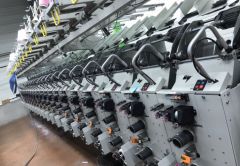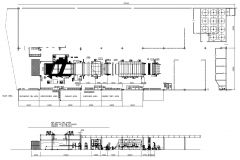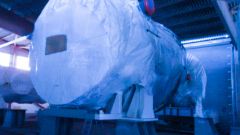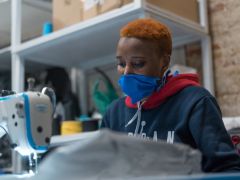Search results for: 'COVERING AIR'
- Related search terms
- air tab
- air com
- air pr
- air pressure
- air table
-
 TT-4949 FADIS AIR COVERING MACHINE WITH 36 POSITIONSTT-4949 FADIS AIR COVERING MACHINE WITH 36 POSITIONS QUANTITY: 1 Learn More
TT-4949 FADIS AIR COVERING MACHINE WITH 36 POSITIONSTT-4949 FADIS AIR COVERING MACHINE WITH 36 POSITIONS QUANTITY: 1 Learn More -
 TT-4948 SSM AIR COVERING WITH 25 POSITIONS, YEAR 2000TT-4948 SSM AIR COVERING WITH 25 POSITIONS, YEAR 2000 QUANTITY: 1 Learn More
TT-4948 SSM AIR COVERING WITH 25 POSITIONS, YEAR 2000TT-4948 SSM AIR COVERING WITH 25 POSITIONS, YEAR 2000 QUANTITY: 1 Learn More -
 TT-2283 SSM TYPE DP2/C AIR COVERING, 40 POSITIONS, YEAR 1999TT-2283 SSM TYPE DP2/C AIR COVERING, 40 POSITIONS, YEAR 1999 QUANTITY: 1 Learn More
TT-2283 SSM TYPE DP2/C AIR COVERING, 40 POSITIONS, YEAR 1999TT-2283 SSM TYPE DP2/C AIR COVERING, 40 POSITIONS, YEAR 1999 QUANTITY: 1 Learn More -
 L-4866 SSM AIR COVERING MACHINE, MODEL DP2/C, 30 POSITIONS, YEAR 1999
L-4866 SSM AIR COVERING MACHINE, MODEL DP2/C, 30 POSITIONS, YEAR 1999YEAR: 1999
Learn More
MODEL: DP2/C
30 POSITIONS
HEBERLEIN JET TYPE P212
FINAL BOBBIN 290mm
SUPERIOR CREEL
OIL DEVICE
IN RUNNING CONDITION
QUANTITY: 1 -
 P-4066 SSM DP2 C AIRJET COVERING 35 POSITIONS
P-4066 SSM DP2 C AIRJET COVERING 35 POSITIONSP-4066 SSM DP2 C AIRJET COVERING 35 POSITIONS
SSM
TYPE: DP2 C
AIRJET COVERING
35 POSITIONS
JET HEBERLEIN TYPE P 213 OR P223
OIL DEVICE
AUTODOFFING
FINAL BOBBIN 290mm
CREEL DOUBLE WITH RESERVE
ALL POSITIONS RUNNING AND MACHINES RUNNINGQUANTITY: 1
Learn More -
 M-6053 SPUNBOND PRODUCTION LINE, WORKING WIDTH 4040mm TO 4500mm
M-6053 SPUNBOND PRODUCTION LINE, WORKING WIDTH 4040mm TO 4500mmM-6053 SPUNBOND PRODUCTION LINE, WORKING WIDTH 4040mm TO 4500mm
OFFER 001
SPUNBOND PRODUCTION LINE
WORKING WIDTH: 4040mm
WEIGHT: 130 TO 250 G/M2OFFER 002
POLYMER CLEANING GROUPOFFER 003
CRYSTALLIZING GROUPOFFER 004
DRYING GROUPOFFER 005
PNEUMATIC CONVEYING SYSTEMOFFER 006
EXTRUDER HOPPEROFFER 007
EXTRUDEROFFER 008
FILTERING UNITOFFER 009
MELT TRANSFER LINEOFFER 010
SPINNING BEAMOFFER 011
SPINNING PACKSOFFER 012
FILAMENTS QUENCHING SYSTEMOFFER 013
FILAMENTS DRAWING AND DISTRIBUTION SYSTEMOFFER 014
WEB FORMING CONVEYOR BELTOFFER 015
CREEL FOR APPLICATION OF REINFORCING FILAMENTSOFFER 016
PRE-NEEDLING MACHINEOFFER 017
NEEDLING MACHINEOFFER 018
THERMOSETTING UNITOFFER 019
OUTLET CALENDEROFFER 020
FOULARDOFFER 021
BINDER PREPARATION SYSTEMOFFER 022
DRYEROFFER 023
OUTLET CALENDEROFFER 024
AUTOMATIC WINDEROFFER 025
AIR COMPRESSORS (FOR FILAMENTS STRETCHING EJECTORS)OFFER 026
DIATHERMIC OIL HEATING SYSTEMOFFER 027
CHILLED WATER CIRCULATION AND GENERATION SYSTEMOFFER 028
EQUIPMENT FOR CLEANING CYCLE, SPECIAL TOOLSOFFER 029
FIBRE DUST RECOVERY SYSTEMOFFER 030
EDGES RECOVERY SYSTEMOFFER 031
SPINNING SECTION STEEL STRUCTUREOFFER 032
DISTRIBUTION ELECTRIC CABINETSOFFER 033
PROCESS ELECTRIC SYSTEM OF EXISTING MACHINES ACCORDING TO THE ACTUAL LAYOUTOFFER 034
CABLES AND CABLING MATERIALSQUANTITY: 1 LINE
Learn More -
 TT-8656 SIEMENS SGT5 4000 F GAS TURBINE & GENERATOR – NEW, 54 MW, YEAR 2016, 50/60 HzTT-8656 SIEMENS SGT5 4000 F GAS TURBINE & GENERATOR – NEW, 54 MW, YEAR 2016, 50/60 Hz 1. NEW AND UNUSED SIEMENS GAS TURBINE & GENERATOR 2. HEAVY DUTY, SINGLE CASING, AXIAL FLOW DESIGN AND DUAL FUEL GAS TURBINE. 3. MODEL: SGT54000F 4. BRAND: SIEMENS AG 5. 54 MW 6. YEAR OF MANUFACTURE: 2016 7. FREQUENCY: 50 Hz 8. FUEL: NATURAL GAS (NG) AND DIESEL OIL (DO) 9. GUARANTEED PERFORMANCE: 10. GROSS POWER OUTPUT [MW]: 298,2 (NG) – 301 (DO). 11. GROSS HEAT RATE [KJ/KWH]: 8979,3 (NG) – 9538,5 (DO). 12. GENERATOR: SGEN51200 A. 13. INCLUDES: BYPASS STACK AND DIVERTER DAMPER. 14. DELIVERY: IMMEDIATELY. BUYER IS RESPONSIBLE FOR LOADING, FREIGHT AND LOGISTICS FROM ACTUAL LOCATION TO FINAL DESTINATION. 15. DETAILED DESCRIPTION: GAS TURBINE (GT) 16. IT WORKS ON 50 Hz BUT COULD BE CONVERTED, WITH ADDITIONAL EQUIPMENT FOR 60 Hz (EXTRA COSTS). QUANTITY: 1 Learn More
TT-8656 SIEMENS SGT5 4000 F GAS TURBINE & GENERATOR – NEW, 54 MW, YEAR 2016, 50/60 HzTT-8656 SIEMENS SGT5 4000 F GAS TURBINE & GENERATOR – NEW, 54 MW, YEAR 2016, 50/60 Hz 1. NEW AND UNUSED SIEMENS GAS TURBINE & GENERATOR 2. HEAVY DUTY, SINGLE CASING, AXIAL FLOW DESIGN AND DUAL FUEL GAS TURBINE. 3. MODEL: SGT54000F 4. BRAND: SIEMENS AG 5. 54 MW 6. YEAR OF MANUFACTURE: 2016 7. FREQUENCY: 50 Hz 8. FUEL: NATURAL GAS (NG) AND DIESEL OIL (DO) 9. GUARANTEED PERFORMANCE: 10. GROSS POWER OUTPUT [MW]: 298,2 (NG) – 301 (DO). 11. GROSS HEAT RATE [KJ/KWH]: 8979,3 (NG) – 9538,5 (DO). 12. GENERATOR: SGEN51200 A. 13. INCLUDES: BYPASS STACK AND DIVERTER DAMPER. 14. DELIVERY: IMMEDIATELY. BUYER IS RESPONSIBLE FOR LOADING, FREIGHT AND LOGISTICS FROM ACTUAL LOCATION TO FINAL DESTINATION. 15. DETAILED DESCRIPTION: GAS TURBINE (GT) 16. IT WORKS ON 50 Hz BUT COULD BE CONVERTED, WITH ADDITIONAL EQUIPMENT FOR 60 Hz (EXTRA COSTS). QUANTITY: 1 Learn More -
 D-2388 What’s the Best Material for a Mask?
D-2388 What’s the Best Material for a Mask?Federal health officials have now recommended that we cover our faces with fabric during the coronavirus pandemic. But what material offers the most protection?
The Centers for Disease Control and Prevention has posted a no-sew mask pattern using a bandanna and a coffee filter as well as a video on making masks using rubber bands and folded fabrics found at home.
While a simple face covering can reduce the spread of coronavirus by blocking outgoing germs from coughs or sneezes of an infected person, experts say there is more variation in how much homemade masks might protect the wearer from incoming germs, depending on the fit and quality of the material used.
Scientists around the country have taken it upon themselves to identify everyday materials that do a better job of filtering microscopic particles. In recent tests, HEPA furnace filters scored well, as did vacuum cleaner bags, layers of 600-count pillowcases and fabric similar to flannel pajamas. Stacked coffee filters had medium scores. Scarves and bandanna material had the lowest scores, but still captured a small percentage of particles.
If you don’t have any of the materials that were tested, a simple light test can help you decide whether a fabric is a good candidate for a mask.
“Hold it up to a bright light,” said Dr. Scott Segal, chairman of anesthesiology at Wake Forest Baptist Health who recently studied homemade masks. “If light passes really easily through the fibers and you can almost see the fibers, it’s not a good fabric. If it’s a denser weave of thicker material and light doesn’t pass through it as much, that’s the material you want to use.”
Researchers say it’s important to remember that lab studies are conducted under perfect conditions with no leaks or gaps in the mask, but the test methods give us a way to compare materials. And while the degree of filtration for some homemade masks seems low, most of us — who are staying home and practicing social distancing in public — don’t need the high level of protection required for medical workers. More important, any face covering is better than none, especially if worn by a person who has the virus but doesn’t know it.
The biggest challenge of choosing a homemade mask material is to find a fabric that is dense enough to capture viral particles, but breathable enough that we can actually wear it. Some items being touted online promise high filtration scores, but the material would be unwearable.
Dressing Up for Work … at Home
Yang Wang, an assistant professor of environmental engineering at Missouri University of Science and Technology, worked with his graduate students to study various combinations of layered materials — including both air filters and fabric. “You need something that is efficient for removing particles, but you also need to breathe,” said Dr. Wang, who last fall won an international award for aerosol research.To test everyday materials, scientists are using methods similar to those used to test medical masks, which everybody agrees should be saved for medical workers who are exposed to high doses of virus from seeing infected patients. The best medical mask — called the N95 respirator — filters out at least 95 percent of particles as small as 0.3 microns. By comparison, a typical surgical mask — made using a rectangular piece of pleated fabric with elastic ear loops — has a filtration efficiency ranging from 60 to 80 percent.
Dr. Wang’s group tested two types of air filters. An allergy-reduction HVAC filter worked the best, capturing 89 percent of particles with one layer and 94 percent with two layers. A furnace filter captured 75 percent with two layers, but required six layers to achieve 95 percent. To find a filter similar to those tested, look for a minimum efficiency reporting value (MERV) rating of 12 or higher or a microparticle performance rating of 1900 or higher.
The problem with air filters is that they potentially could shed small fibers that would be risky to inhale. So if you want to use a filter, you need to sandwich the filter between two layers of cotton fabric. Dr. Wang said one of his grad students made his own mask by following the instructions in the C.D.C. video, but adding several layers of filter material inside a bandanna.
Dr. Wang’s group also found that when certain common fabrics were used, two layers offered far less protection than four layers. A 600 thread count pillow case captured just 22 percent of particles when doubled, but four layers captured nearly 60 percent. A thick woolen yarn scarf filtered 21 percent of particles in two layers, and 48.8 percent in four layers. A 100 percent cotton bandanna did the worst, capturing only 18.2 percent when doubled, and just 19.5 percent in four layers.
The group also tested Brew Rite and Natural Brew basket-style coffee filters, which, when stacked in three layers, showed 40 to 50 percent filtration efficiency — but they were less breathable than other options.
If you are lucky enough to know a quilter, ask them to make you a mask. Tests performed at the Wake Forest Institute for Regenerative Medicine in Winston-Salem, N.C., showed good results for homemade masks using quilting fabric. Dr. Segal, of Wake Forest Baptist Health, who led the study, noted that quilters tend to use high-quality, high-thread count cotton. The best homemade masks in his study were as good as surgical masks or slightly better, testing in the range of 70 to 79 percent filtration. Homemade masks that used flimsier fabric tested as low as 1 percent filtration, Dr. Segal said.
The best-performing designs were a mask constructed of two layers of high-quality, heavyweight “quilter’s cotton,” a two-layer mask made with thick batik fabric, and a double-layer mask with an inner layer of flannel and outer layer of cotton.
Bonnie Browning, executive show director for the American Quilter’s Society, said that quilters prefer tightly woven cottons and batik fabrics that stand up over time. Ms. Browning said most sewing machines can handle only two layers of fabric when making a pleated mask, but someone who wanted four layers of protection could wear two masks at a time.
Ms. Browning said she recently reached out to quilters on Facebook and heard from 71 people who have made a combined total of nearly 15,000 masks. “We quilters are very much in the thick of what’s going on with this,” said Ms. Browning, who lives in Paducah, Ky. “One thing most of us have is a stash of fabric.”
People who don’t sew could try a folded origami mask, created by Jiangmei Wu, assistant professor of interior design at Indiana University. Ms. Wu, who is known for her breathtaking folded artwork, said she began designing a folded mask out of a medical and building material called Tyvek, as well as vacuum bags, after her brother in Hong Kong, where mask wearing is common, suggested it. (DuPont, the maker of Tyvek, said in a statement that Tyvek is intended for medical apparel, not masks.) The folded mask pattern is free online, as is a video demonstrating the folding process. In tests at Missouri University and University of Virginia, scientists found that vacuum bags removed between 60 percent and 87 percent of particles. But some brands of vacuum bags may contain fiberglass or are harder to breathe through than other materials, and shouldn’t be used. Ms. Wu used a bag by EnviroCare Technologies, which has said it does not use fiberglass in its paper and synthetic cloth bags.
“I wanted to create an alternative for people who don’t sew,” said Ms. Wu, who said she is talking to various groups to find other materials that will be effective in a folded mask. “Given the shortage of all kinds of materials, even vacuum bags might run out.”
The scientists who conducted the tests used a standard of 0.3 microns because that is the measure used by the National Institute for Occupational Safety and Health for medical masks.
Linsey Marr, a Virginia Tech aerosol scientist and an expert in the transmission of viruses, said the certification method for respirators and HEPA filters focuses on 0.3 microns because particles around that size are the hardest to catch. While it seems counterintuitive, particles smaller than 0.1 microns are actually easier to catch because they have a lot of random motion that makes them bump into the filter fibers, she said.
“Even though coronavirus is around 0.1 microns, it floats around in a wide range of sizes, from around 0.2 to several hundred microns, because people shed the virus in respiratory fluid droplets that also contain lots of salts and proteins and other things,” said Dr. Marr. “Even if the water in the droplets fully evaporates, there’s still a lot of salt and proteins and other gunk that stays behind as solid or gel-like material. I think 0.3 microns is still useful for guidance because the minimum filtration efficiency will be somewhere around this size, and it’s what NIOSH uses.”
Learn More -
 TT-8645 OPEN WIDTH WASHING MACHINE FOR WOVEN FABRIC, WORKING WIDTH 1800mm, 5 WASHING CHAMBERS, 2 WASHING DRUMS IN EACH CHAMBERTT-8645 OPEN WIDTH WASHING MACHINE FOR WOVEN FABRIC, WORKING WIDTH 1800mm, 5 WASHING CHAMBERS, 2 WASHING DRUMS IN EACH CHAMBER 1. OPEN WIDTH WASHING MACHINE FOR WOVEN FABRIC 2. WORKING WIDTH: 1800mm 3. 5 WASHING CHAMBERS 4. 2 WASHING DRUM IN EACH CHAMBER 5. DRIVING SIDE: (PLEASE SPECIFY) Learn More
TT-8645 OPEN WIDTH WASHING MACHINE FOR WOVEN FABRIC, WORKING WIDTH 1800mm, 5 WASHING CHAMBERS, 2 WASHING DRUMS IN EACH CHAMBERTT-8645 OPEN WIDTH WASHING MACHINE FOR WOVEN FABRIC, WORKING WIDTH 1800mm, 5 WASHING CHAMBERS, 2 WASHING DRUMS IN EACH CHAMBER 1. OPEN WIDTH WASHING MACHINE FOR WOVEN FABRIC 2. WORKING WIDTH: 1800mm 3. 5 WASHING CHAMBERS 4. 2 WASHING DRUM IN EACH CHAMBER 5. DRIVING SIDE: (PLEASE SPECIFY) Learn More -
 TT-5852 MASCOTT PLUS 25-30 CROSSLAPPER AND MONO_1AB_27-3000 NEEDLE LOOMTT-5852 MASCOTT PLUS 25-30 CROSSLAPPER AND MONO_1AB_27-3000 NEEDLE LOOM Learn More
TT-5852 MASCOTT PLUS 25-30 CROSSLAPPER AND MONO_1AB_27-3000 NEEDLE LOOMTT-5852 MASCOTT PLUS 25-30 CROSSLAPPER AND MONO_1AB_27-3000 NEEDLE LOOM Learn More
